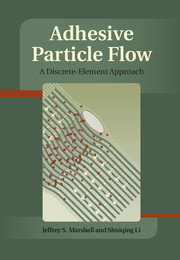3654 results in ebooks in fluid mechanics
11 - Turbulence: generalities; scaling laws for shear flows
-
- Book:
- Flow, Deformation and Fracture
- Published online:
- 05 June 2014
- Print publication:
- 05 June 2014, pp 182-224
-
- Chapter
- Export citation

Adhesive Particle Flow
- A Discrete-Element Approach
-
- Published online:
- 05 June 2014
- Print publication:
- 31 March 2014
7 - The Newtonian viscous fluid approximation. General comments and basic relations
-
- Book:
- Flow, Deformation and Fracture
- Published online:
- 05 June 2014
- Print publication:
- 05 June 2014, pp 124-136
-
- Chapter
- Export citation
9 - Advanced similarity methods: complete and incomplete similarity
-
- Book:
- Flow, Deformation and Fracture
- Published online:
- 05 June 2014
- Print publication:
- 05 June 2014, pp 150-163
-
- Chapter
- Export citation
12 - Turbulence: mathematical models of turbulent shear flows and of the local structure of turbulent flows at very large Reynolds numbers
-
- Book:
- Flow, Deformation and Fracture
- Published online:
- 05 June 2014
- Print publication:
- 05 June 2014, pp 225-242
-
- Chapter
- Export citation
5 - The linear elastic solid approximation. Basic equations and boundary value problems in the linear theory of elasticity
-
- Book:
- Flow, Deformation and Fracture
- Published online:
- 05 June 2014
- Print publication:
- 05 June 2014, pp 79-100
-
- Chapter
- Export citation
Foreword
-
- Book:
- Flow, Deformation and Fracture
- Published online:
- 05 June 2014
- Print publication:
- 05 June 2014, pp xi-xii
-
- Chapter
- Export citation
8 - The Newtonian viscous fluid approximation. Applications: the boundary layer
-
- Book:
- Flow, Deformation and Fracture
- Published online:
- 05 June 2014
- Print publication:
- 05 June 2014, pp 137-149
-
- Chapter
- Export citation
5 - Interpolation
-
- Book:
- Numerical Analysis for Engineers and Scientists
- Published online:
- 05 June 2014
- Print publication:
- 29 May 2014, pp 125-152
-
- Chapter
- Export citation
2 - Direct solution of linear systems
-
- Book:
- Numerical Analysis for Engineers and Scientists
- Published online:
- 05 June 2014
- Print publication:
- 29 May 2014, pp 22-55
-
- Chapter
- Export citation
6 - Iterative methods and the roots of polynomials
-
- Book:
- Numerical Analysis for Engineers and Scientists
- Published online:
- 05 June 2014
- Print publication:
- 29 May 2014, pp 153-181
-
- Chapter
- Export citation
Frontmatter
-
- Book:
- Numerical Analysis for Engineers and Scientists
- Published online:
- 05 June 2014
- Print publication:
- 29 May 2014, pp i-iv
-
- Chapter
- Export citation
1 - Numerical error
-
- Book:
- Numerical Analysis for Engineers and Scientists
- Published online:
- 05 June 2014
- Print publication:
- 29 May 2014, pp 1-21
-
- Chapter
- Export citation
8 - Data fitting
-
- Book:
- Numerical Analysis for Engineers and Scientists
- Published online:
- 05 June 2014
- Print publication:
- 29 May 2014, pp 213-242
-
- Chapter
- Export citation
11 - Introduction to stochastic ODEs
-
- Book:
- Numerical Analysis for Engineers and Scientists
- Published online:
- 05 June 2014
- Print publication:
- 29 May 2014, pp 302-325
-
- Chapter
- Export citation
4 - Iterative approaches for linear systems
-
- Book:
- Numerical Analysis for Engineers and Scientists
- Published online:
- 05 June 2014
- Print publication:
- 29 May 2014, pp 93-124
-
- Chapter
- Export citation
Index
-
- Book:
- Numerical Analysis for Engineers and Scientists
- Published online:
- 05 June 2014
- Print publication:
- 29 May 2014, pp 567-572
-
- Chapter
- Export citation
12 - A big integrative example
-
- Book:
- Numerical Analysis for Engineers and Scientists
- Published online:
- 05 June 2014
- Print publication:
- 29 May 2014, pp 326-352
-
- Chapter
- Export citation
Appendix B - Sample codes
-
- Book:
- Numerical Analysis for Engineers and Scientists
- Published online:
- 05 June 2014
- Print publication:
- 29 May 2014, pp 371-453
-
- Chapter
- Export citation
Solutions
-
- Book:
- Numerical Analysis for Engineers and Scientists
- Published online:
- 05 June 2014
- Print publication:
- 29 May 2014, pp 454-554
-
- Chapter
- Export citation
